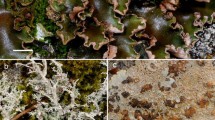Tintenstrich
communities receive their name from the black strips on rocks, which are particularly spectacular on the background of white limestone and dolomite. They are dominated by cyanobacteria, green photosynthesizing procaryotes. However, cyanobacterial crusts are ubiquitous and much more widespread. On bare substratum on walls and rocks in temperate, arid, and tropical zones they are subject to severe stress by insolation, heat, and either too little or too much water. An array of ecophysiological traits allow them to endure this multifactorial stress. Particular features of their photosynthetic membranes may facilitate dissipation of surplus photosynthetically active radiation; special sun-screen pigments protect them from UV radiation, they are desiccation tolerant, concentrate inorganic carbon for photosynthetic fixation, and assimilate atmospheric dinitrogen. With their own success on bare substratum they become pioneers for other organisms.
Similar content being viewed by others
Author information
Authors and Affiliations
Rights and permissions
About this article
Cite this article
Lüttge, U. Cyanobacterial Tintenstrich Communities and their Ecology. Naturwissenschaften 84, 526–534 (1997). https://doi.org/10.1007/s001140050439
Issue Date:
DOI: https://doi.org/10.1007/s001140050439




